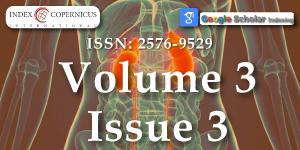Diabetes and chronic kidney disease: a rare cause for a very common association
Main Article Content
Abstract
The authors present the case of a 45-year-old female patient with diabetes and chronic kidney disease (CKD). She had unsatisfactory glycemic control, and showed some intellectual limitations. Her urine exam was unremarkable, and her renal ultrasound revealed single right kidney with aspects suggesting ureteropelvic junction syndrome. Her mother had also suffered from diabetes and CKD G5D presenting in the sixth to seventh decade.
An hereditary cause for CKD was considered, which led the authors to investigate an autosomal dominant cause for CKD with a tubulointerstitial phenotype, taking into account the personal and family history for diabetes and also the renal imaging; a large deletion in the HNF-1β gene was identified through Multiplex Ligand Probe Assay (MLPA) analysis, explaining the phenotype.
Genetic causes of CKD should be considered in the presence of positive family history for CKD, and the coexistence of diabetes with bland urine sediment should raise the possibility of a syndromic cause of the phenotype, namely involving HNF-1β gene mutations or deletions.
Article Details
Copyright (c) 2019 Fonseca JA, et al.

This work is licensed under a Creative Commons Attribution 4.0 International License.
Mehta L, Jim B. Hereditary Renal Diseases. Semin Nephrol. 2017; 37: 354-361. PubMed: https://www.ncbi.nlm.nih.gov/pubmed/28711074
Bleyer A, Kmoch S. Autosomal dominant tubulointerstitial kidney disease: of names and genes. Kidney Int. 2014; 86: 459–461. PubMed: https://www.ncbi.nlm.nih.gov/pubmed/25168494
Eckardt KU, Alper SL, Antignac C, Bleyer AJ, Chauveau D, et al. Autosomal dominant tubulointerstitial kidney disease: diagnosis, classification, and management—A KDIGO consensus report. Kidney Int. 2015; 88: 676-683. PubMed: https://www.ncbi.nlm.nih.gov/pubmed/25738250
Coffinier C, Barra J, Babinet C, Yaniv M. Expression of the vHNF1/HNF1beta homeoprotein gene during mouse organogenesis. Mech Dev. 1999; 89: 211–213. PubMed: https://www.ncbi.nlm.nih.gov/pubmed/10559500
Kolatsi-Joannou M, Bingham C, Ellard S, Bulman MP, Allen LI, et al. Hepatocyte nuclear factor-1beta: a new kindred with renal cysts and diabetes and gene expression in normal human development. J Am Soc Nephrol. 2001; 12: 2175–2180. PubMed: https://www.ncbi.nlm.nih.gov/pubmed/11562418
Desgrange A, Heliot C, Skovorodkin I, Akram SU, Heikkilä J, et al. HNF1B controls epithelial organization and cell polarity during ureteric bud branching and collecting duct morphogenesis. Development. 2017; 15: 144: 4704-4719. PubMed: https://www.ncbi.nlm.nih.gov/pubmed/29158444
Raaijmakers A, Corveleyn A, Devriendt K, van Tienoven TP, Allegaert K, et al. Criteria for HNF1B analysis in patients with congenital abnormalities of kidney and urinary tract. Nephrol Dial Transplant. 2015; 30: 835-842. PubMed: https://www.ncbi.nlm.nih.gov/pubmed/25500806
Clissold RL, Hamilton AJ, Hattersley AT, Ellard S, Bingham C. HNF1B-associated renal and extra-renal disease-an expanding clinical spectrum. Nat Rev Nephrol. 2015; 11: 102-112. PubMed: https://www.ncbi.nlm.nih.gov/pubmed/25536396
Bockenhauer D, Jaureguiberry G . HNF1B-associated clinical phenotypes: the kidney and beyond. Pediatr Nephrol. 2016; 31: 707-714. PubMed: https://www.ncbi.nlm.nih.gov/pubmed/26160100
Heidet L, Decramer S, Pawtowski A, Morinière V, Bandin F, et al. Spectrum of HNF1B mutations in a large cohort of patients who harbor renal diseases. Clin J Am Soc Nephrol. 2010; 5: 1079-1090. PubMed: https://www.ncbi.nlm.nih.gov/pubmed/20378641
Weber S, Moriniere V, Knuppel T, Charbit M, Dusek J, et al. Prevalence of mutations in renal developmental genes in children with renal hypodysplasia: results of the ESCAPE study. J Am Soc Nephrol. 2006; 17: 2864–2870. PubMed: https://www.ncbi.nlm.nih.gov/pubmed/16971658
Ulinski T, Bensman A, Lescure S. Abnormalities of hepatocyte nuclear factor (HNF)-1beta: biological mechanisms, phenotypes, and clinical consequences. Arch Pediatr. 2009; 16: 1049-1056. PubMed: https://www.ncbi.nlm.nih.gov/pubmed/19361964
van der Made CI, Hoorn EJ, de la Faille R, Karaaslan H, Knoers NV, et al. Hypomagnesemia as First Clinical Manifestation of ADTKD-HNF1B: A Case Series and Literature Review. Am J Nephrol. 2015; 42: 85-90. PubMed: https://www.ncbi.nlm.nih.gov/pubmed/26340261
Decramer S, Parant O, Beaufils S, Clauin S, Guillou C, et al. Anomalies of the TCF2 gene are the main cause of fetal bilateral hyperechogenic kidneys. J Am Soc Nephrol. 2007; 18: 923–993. PubMed: https://www.ncbi.nlm.nih.gov/pubmed/17267738
Clissold RL, Ashfield B, Burrage J, Hannon E, Bingham C, et al. Genome-wide methylomic analysis in individuals with HNF1B intragenic mutation and 17q12 microdeletion. Clin Epigenetics. 2018; 10: 97. PubMed: https://www.ncbi.nlm.nih.gov/pubmed/30021660
Faguer S, Chassaing N, Bandin F, Prouheze C, Garnier A, et al. The HNF1B score is a simple tool to select patients for HNF1B gene analysis. Kidney Int. 2014; 86: 1007-1015. PubMed: https://www.ncbi.nlm.nih.gov/pubmed/24897035
Chan SC, Zhang Y, Shao A, Avdulov S, Herrera J, et al. Mechanism of fibrosis in HNF1 Brelated autosomal dominant tubulointerstitial kidney disease. J Am Soc Nephrol. 2018; 29: 2493–2509. PubMed: https://www.ncbi.nlm.nih.gov/pubmed/30097458
Lata S, Marasa M, Li Y, Fasel DA, Groopman E, et al. Whole-exome sequencing in adults with chronic kidney disease: a pilot study. Ann Intern Med. 2018; 168; 100–109. PubMed: https://www.ncbi.nlm.nih.gov/pubmed/29204651

